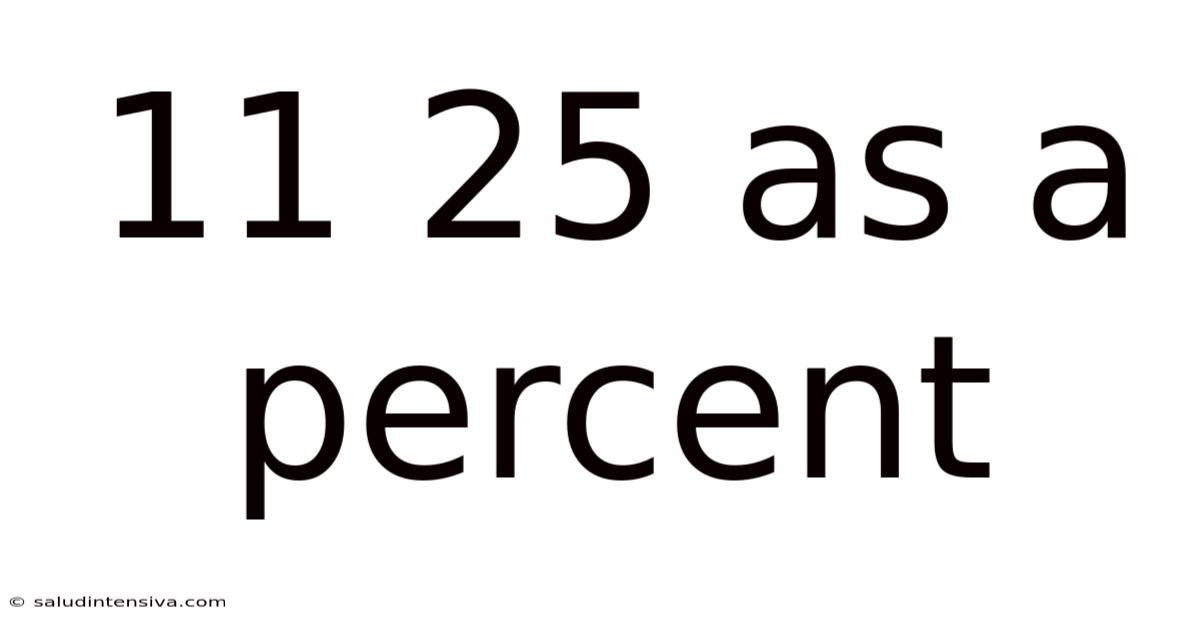11 25 As A Percent
saludintensiva
Sep 16, 2025 · 4 min read

Table of Contents
Understanding 11/25 as a Percentage: A Comprehensive Guide
Expressing fractions as percentages is a fundamental skill in mathematics with widespread applications in everyday life, from calculating discounts and interest rates to understanding statistics and data analysis. This article will delve into the process of converting the fraction 11/25 into a percentage, exploring different methods, providing detailed explanations, and offering further insights into percentage calculations. We'll also address common questions and misconceptions surrounding this topic.
Understanding Fractions and Percentages
Before we dive into converting 11/25, let's briefly review the concepts of fractions and percentages. A fraction represents a part of a whole. It consists of a numerator (the top number) and a denominator (the bottom number). The denominator indicates the total number of equal parts the whole is divided into, and the numerator indicates how many of those parts are being considered.
A percentage, on the other hand, is a way of expressing a fraction as a proportion of 100. The symbol "%" represents "per cent," meaning "out of one hundred." Therefore, 50% means 50 out of 100, which is equivalent to the fraction 50/100, or 1/2.
Method 1: Converting the Fraction Directly
The most straightforward method to convert 11/25 to a percentage is to manipulate the fraction so that its denominator becomes 100. Since 25 multiplied by 4 equals 100, we'll multiply both the numerator and the denominator by 4:
(11 * 4) / (25 * 4) = 44/100
Since a percentage is a fraction out of 100, 44/100 is equivalent to 44%.
Method 2: Using Decimal Conversion
Another approach involves converting the fraction to a decimal first and then multiplying by 100 to express it as a percentage. To convert 11/25 to a decimal, we divide the numerator (11) by the denominator (25):
11 ÷ 25 = 0.44
Now, we multiply the decimal by 100 to obtain the percentage:
0.44 * 100 = 44%
Both methods yield the same result: 11/25 is equal to 44%.
Method 3: Using Proportion
We can also solve this using proportions. We know that x% is equivalent to 11/25. Therefore, we can set up a proportion:
x/100 = 11/25
To solve for x, we can cross-multiply:
25x = 1100
Now, divide both sides by 25:
x = 1100 ÷ 25 = 44
Therefore, x = 44%
Real-World Applications of Percentage Calculations
Understanding how to convert fractions to percentages is crucial in various real-world scenarios. Consider these examples:
- Discounts: If a store offers a 44% discount on an item, you can easily calculate the savings.
- Taxes: Calculating sales tax or income tax often involves working with percentages.
- Interest Rates: Understanding interest rates on loans or investments relies heavily on percentage calculations.
- Statistical Analysis: Percentages are widely used to represent data in various fields, such as market research, finance, and healthcare.
- Grade Calculations: Many academic systems use percentages to represent student performance.
Further Exploration: Working with Percentages
Beyond converting fractions to percentages, it's important to understand other percentage-related calculations:
- Calculating a percentage of a number: For example, finding 44% of 200 would involve multiplying 200 by 0.44 (which is 44/100). This would result in 88.
- Finding the percentage increase or decrease: This involves comparing two numbers and calculating the percentage change.
- Converting percentages back to fractions or decimals: This is the reverse process of what we've covered, and it's equally important.
Frequently Asked Questions (FAQ)
-
Q: Why is it important to learn how to convert fractions to percentages?
- A: It's crucial for understanding and applying mathematical concepts in various real-world contexts, from finance to everyday shopping. It's a fundamental skill needed for numerous applications.
-
Q: Are there other ways to convert 11/25 to a percentage?
- A: While the methods outlined above are the most common and efficient, you could also use a calculator with a percentage function, or you could employ more complex algebraic manipulations, although they are less practical for this specific problem.
-
Q: What if the fraction doesn't easily convert to a denominator of 100?
- A: You can still use the decimal conversion method: divide the numerator by the denominator to get a decimal, then multiply by 100. The result may be a decimal percentage (e.g., 33.33%).
-
Q: How do I handle percentages greater than 100%?
- A: Percentages greater than 100% simply represent values exceeding the original whole. For example, a 150% increase means the final value is 1.5 times the original value.
-
Q: Can negative percentages exist?
- A: Yes, negative percentages represent decreases or losses. For example, a -10% change signifies a decrease of 10%.
Conclusion
Converting 11/25 to a percentage is a straightforward process, achievable through several methods. Understanding these methods is crucial for mastering percentage calculations and applying them effectively in various real-world situations. Remember that the core concept involves representing a fraction as a proportion of 100. Whether you choose to directly manipulate the fraction, utilize decimal conversion, or apply the proportion method, the final answer remains the same: 11/25 is equivalent to 44%. Mastering this fundamental skill paves the way for more advanced mathematical concepts and practical applications in numerous fields. Continue practicing different percentage problems to solidify your understanding and build confidence in tackling more complex calculations.
Latest Posts
Latest Posts
-
9 7 In Decimal Form
Sep 16, 2025
-
21 30 Is What Time
Sep 16, 2025
-
5 Out Of 25 Percentage
Sep 16, 2025
-
1 3 As A Mixed Number
Sep 16, 2025
-
50 000 In Roman Numerals
Sep 16, 2025
Related Post
Thank you for visiting our website which covers about 11 25 As A Percent . We hope the information provided has been useful to you. Feel free to contact us if you have any questions or need further assistance. See you next time and don't miss to bookmark.